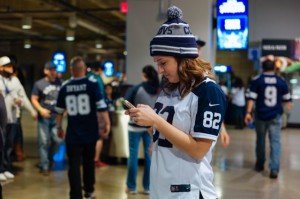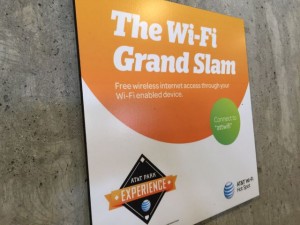Thanks to the smart folks who built the Levi’s Stadium Wi-Fi network — and the smart deployers and carrier partners who doubled down on the DAS this summer — the venue was able to handle an incredible 26 terabytes of wireless data on Super Sunday, with 15.9 TB amongst the four major cellular carriers on the DAS, and 10.1 TB on the stadium’s Wi-Fi network. Both were easily new records for single-day events, far eclipsing the totals seen at Super Bowl XLIX the year before.
The question, of course, for everyone else is: What comes next? And what does that mean for networks built in the past few years?
Keep building for growth
Editor’s note: This column is an excerpt from our latest STADIUM TECHNOLOGY REPORT, which is available for FREE DOWNLOAD from our site. In addition to this analysis and stadium tech deployment profiles we also take an in-depth look at the new trend of deploying Wi-Fi and DAS antennas under seats, and provide a wireless recap from Super Bowl 50. GET YOUR COPY today!
In some follow-up discussions with folks from Aruba, the Levi’s Stadium networking team, Verizon Wireless and others in the industry, I wondered out loud if what we are seeing is just yearly growth in demand, or whether expanded networks are merely satisfying pent-up demand that was always there.To be sure, the “big” events like the Super Bowl, the World Series and the Final Four are always going to generate outsize traffic numbers, especially as more and more fans join the selfie craze and post photos and videos from the stadium, showing the rest of the world how great their life is. According to Verizon, the amount of traffic uploaded on their DAS network at Super Bowl 50 was double the upload traffic the carrier saw at Super Bowl XLIX, validating Verizon’s belief that traffic was going to grow significantly.
For mobile traffic in general, and for in-stadium wireless activity specifically, the continued growth over the past few years can likely be traced to a number of factors, including the ever-increasing power of mobile devices; the new number of bandwidth-hungry apps that incorporate images and video; and a steady increase in familiarity with devices and apps, as older folks — those more likely to purchase event tickets — catch up to their kids in wanting to use, and being able to use, the content-sharing features of social media and other communication apps. And, simply, more people trying and successfully connecting to in-stadium networks, reversing historical thinking that told them from experience in past years that connecting at a stadium was futile. In almost all venues these days, no longer is that the case.
So with no end yet in sight to the general doubling of traffic on a year to year basis, the big question out there for stadium technology teams has to be — is what we have now enough to handle growing needs, and if not, what are we going to do about it? The fact that cellular carriers (correctly) assumed they needed to add capacity to the Levi’s Stadium DAS a year after it was deployed should give pause to anyone building a network right now; though your venue may not be hosting the Super Bowl anytime soon, it might not hurt to re-think the traffic projections that have been made and step them up a bit, just in case.
On both the Wi-Fi side and the DAS side, we may also be looking soon at a need for new kinds of technology to help build the networks of the near future. In this issue we take an in-depth look at the trend toward putting antennas for both Wi-Fi and DAS under seats, mainly to build networks that are more dense and can handle more traffic.Verizon, which pioneered DAS under-seat antennas at Levi’s Stadium this year, said it is already seeing stadiums where just adding another sector of traditional DAS produces diminishing returns; if traffic on both types of networks keeps growing at the current rate, when will existing designs become obsolete? And what will replace them?
Stadium network owners shouldn’t ignore policy
As stadium-networking types ponder the future, it would serve the industry well to start thinking together as well, especially in the areas of telecom policy and standards-setting. As the builders of telecom networks worldwide ponder the future of 5G technologies there are some discussions where stadium networking representatives are nowhere to be found, especially in the potentially troubling direction of LTE-U, the idea of carriers using unlicensed bands for LTE traffic.
It’s still early days in the LTE-U discussions, but a recent decision by the FCC to allow carriers to conduct tests of the technology should be a call to action for the stadium networking industry. While nobody knows quite for sure yet what will happen to an in-venue Wi-Fi network if and when LTE-U traffic appears, it seems to make sense for the industry to get together and at least present some kind of unified voice before decisions get made.
At the recent Silicon Flatirons telecom policy conference in Boulder, Colo., there were exactly zero representatives from the venue Wi-Fi ecosystem present, including no visible representation from the Wi-Fi and DAS gear manufacturers who sell into the stadium networking space. With telecom providers hungry for spectrum of any kind, it’s a fool’s bet to assume that the unlicensed bands used in stadiums worldwide today will remain as free and available as they are now. It’s just another factor that’s needed to be considered, as venue tech professionals plan for a future of ever-increasing needs.










Speak Your Mind